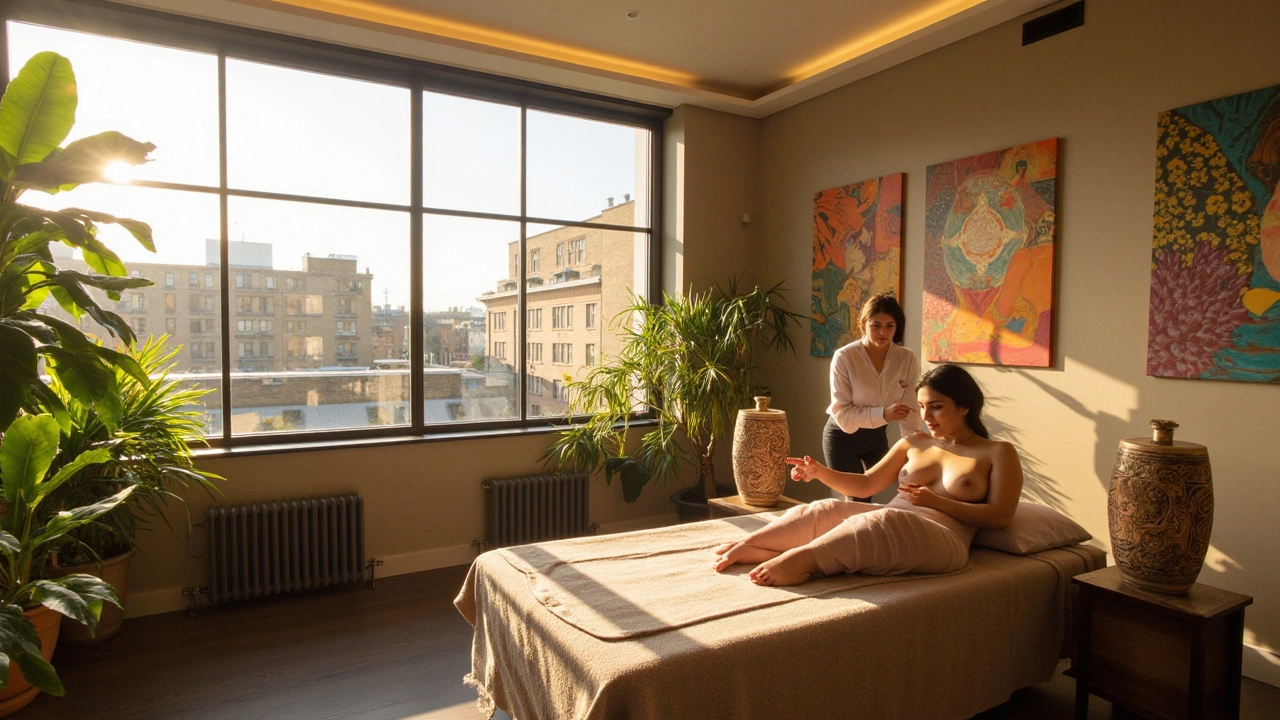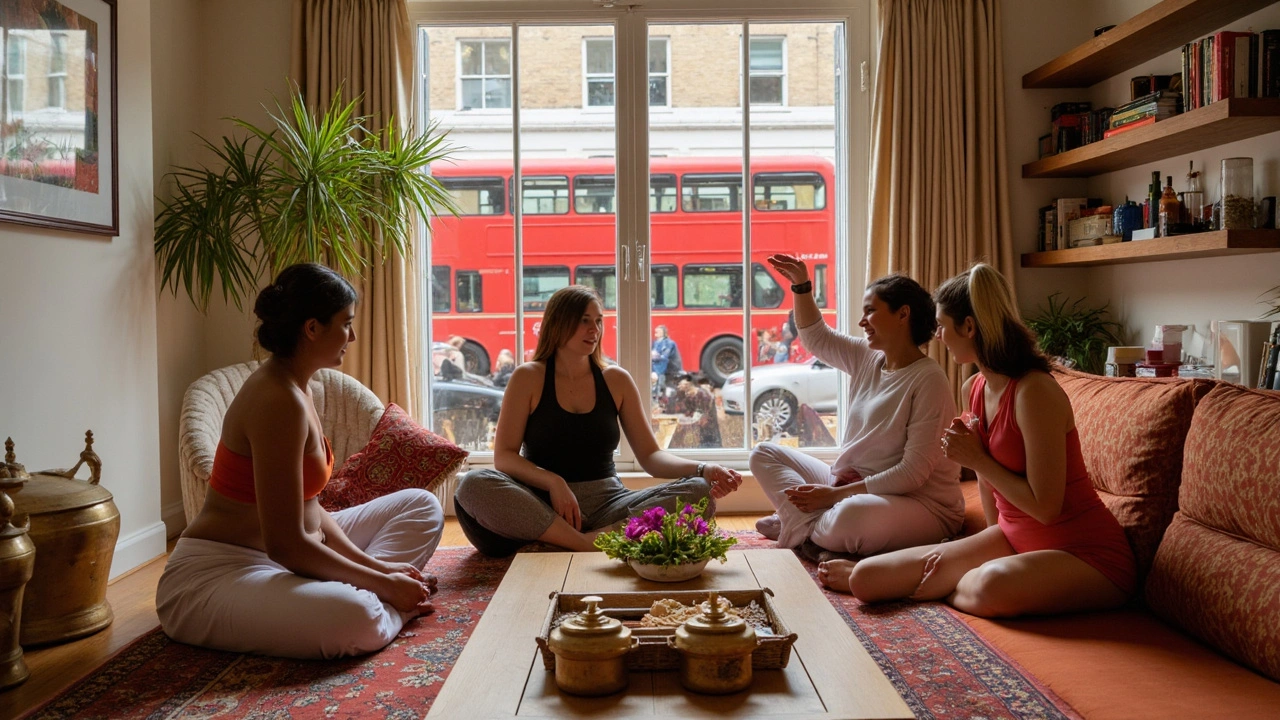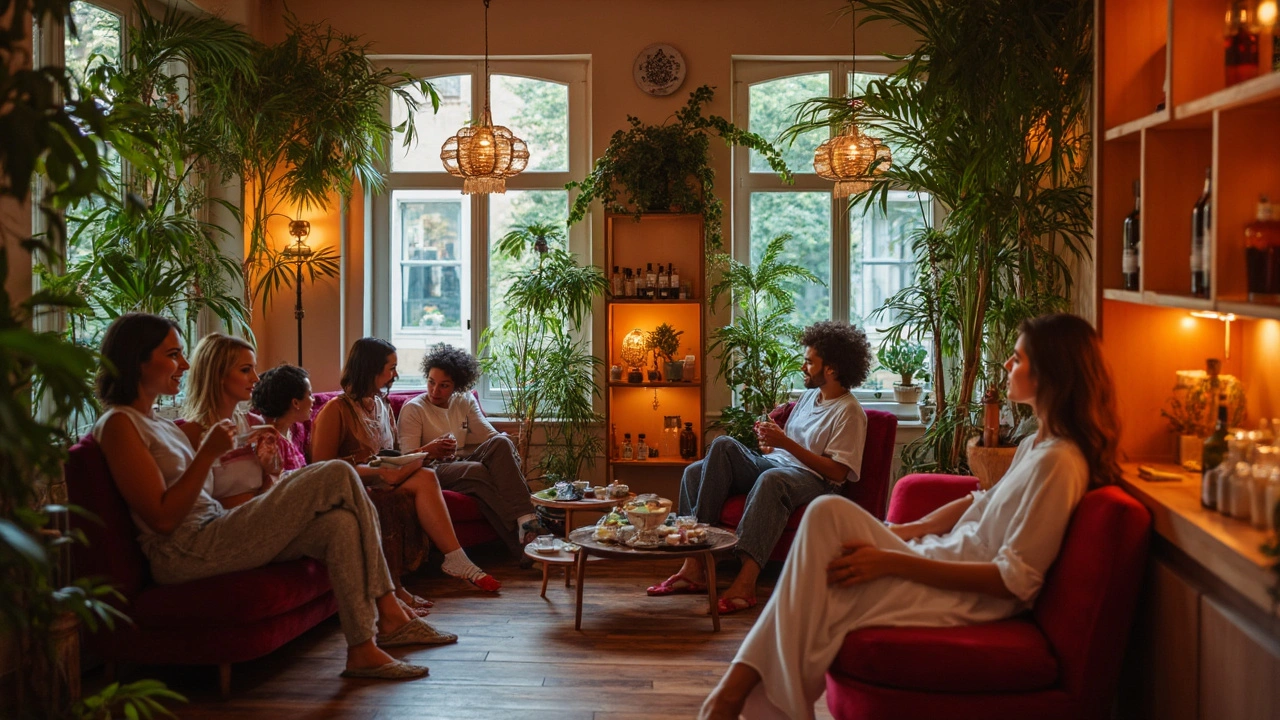Indian Massage London: Unlocking Its Healing Power

Ever feel like your whole body is a knot from rushing around London? You're not the only one. Indian massage, sometimes called Ayurvedic massage, is seriously trending in the city for one big reason: it doesn't just loosen you up. It actually helps your mind and body heal.
There's nothing mysterious about it. These massages focus on warm oils, steady pressure, and certain strokes that target both your muscles and your nervous system. If you've dealt with stubborn tension in your shoulders, restless sleep, or just nonstop stress, these techniques can help clear it out in a way that standard Western massages often don't.
But not every place that claims "Indian massage" is the real deal. Knowing what sets true Indian massage apart—and how to spot unqualified spots—can save you a lot of disappointment. I’ve tried a bunch myself, from a quick head rub in Southall to full-on spa sessions in central London. Here’s what you should know (and look out for) before you book your first appointment.
- Why Indian Massage Is Different
- Most Popular Types in London
- Health Benefits You Can Actually Feel
- How to Pick the Right London Spa
- What Happens During a Session
- Tips to Maximize Your Results
Why Indian Massage Is Different
If you've been to a regular massage place in London, you might think you know what to expect—some oils, maybe relaxing music, and a bit of kneading. But Indian massage, or what spas often call Ayurvedic massage, comes from a totally different mindset. It's not just about working out a knot in your back. The focus is on total balance: your muscles, energy, mind, and even your digestion.
The roots go back over 3,000 years. In India, massage isn’t a luxury; it's a normal part of family life. Even newborn babies get regular oil massages at home. The oils aren't random—they're carefully chosen based on your body type (what in Ayurveda is called "dosha"). Some places in London even use sesame or coconut oil for this reason, because these oils are thought to go deep into your skin and calm your nerves.
The strokes feel different, too. You get long, sweeping movements in body massage (Abhyanga), and quick but gentle tapping in traditional head massage (Champissage). The therapist might even work on key energy points, called "marmas," which are a bit like acupressure spots. Genuine Indian massage involves:
- Personalized oil blends based on your dosha
- Emphasis on energy channels and points
- Focus on balancing mind and body—not just temporary relaxation
- Special techniques for head, face, and scalp (not just the back!)
One thing to know: indian massage therapists usually stay much more focused and intentional with their touch, instead of just sweeping back and forth like a Swedish massage. Many Londoners are surprised by how targeted it is, and how quickly it melts deep-seated tension and stress.
If you still have doubts about whether this old-school style can hang with modern science, check this out:
| Aspect | Western Massage | Indian Massage (Ayurvedic) |
|---|---|---|
| Oil Selection | Mainly for slip | Personalized, based on body/mind type |
| Focus | Muscle relief | Muscles, nerves, and energy balance |
| Health Goals | Relaxation, pain relief | Relaxation, immunity, sleep, digestion, mental calm |
| Frequency | Occasional treat | Part of health routine |
No matter your reason for searching for Indian massage in London, just knowing what makes it different helps you weed out the cheap copycats from the real thing. If you want more than just muscle relief, and you're ready to try something that actually fits into a serious wellness routine, Indian massage is on a whole other level.
Most Popular Types in London
When you search for indian massage in London, you’re likely to come across a few specific styles again and again. Understanding what each one actually does can help you pick the right treatment for whatever aches or issues you want to tackle.
Ayurvedic Abhyanga is a big one. This is the full-body oil massage that’s all about bringing balance to your body’s systems. It uses warm, herb-infused oils and rhythmic strokes, and you’ll often hear claims that it boosts circulation, helps you sleep deeper, and leaves your skin feeling ridiculously good. Even big-name spa chains like Champneys have started offering versions of Abhyanga, so it’s not just a niche thing anymore.
Then there’s Indian Head Massage, known as Champissage. This one zooms in on your scalp, neck, and shoulders—perfect for anyone who sits at a desk or stares at screens all day. A therapist will use a mix of pressure points, gentle pulling, and rhythmic tapping. Lots of London workplaces bring in Champissage as a stress-buster for staff. It’s quick (usually around 20-30 minutes) but feels like you've rebooted your entire brain. According to the British Association of Beauty Therapy & Cosmetology, "Clients report reduced tension and even fewer headaches after a head massage."
For sports injuries and sore muscles, some clinics also offer traditional Marma therapy. It’s less common than Abhyanga or Champissage, but you can find it in South Asian neighborhoods like Southall and Wembley. Marma targets pressure points across the body—sort of like acupressure but with Ayurvedic roots.
If you hear about Udvartana, that's a dry herbal powder massage, mostly for exfoliating skin and boosting energy. It’s got a tiny following, but there are a few places offering it for those who want something different from the usual oil treatments.
Here’s a quick cheat sheet to remember what’s what:
- Abhyanga: Full-body oil massage for stress and balance.
- Champissage: Head, neck, and shoulders—great for fast relief from tension.
- Marma therapy: Deep tissue and pressure points for chronic pain and injury.
- Udvartana: Herbal scrub, boosts circulation and smooths skin.
Most reputable spas will explain the differences and let you pick, but don’t be shy to ask questions if they don’t.
Health Benefits You Can Actually Feel
When people talk about the healing power of Indian massage, they’re not hyping it up for nothing. It’s not just about feeling nice for a bit—it’s what happens after that really matters. People who get regular Indian massages often notice they’re sleeping better, moving with less pain, and even feeling happier day to day.
The core techniques, like warm oil massages (Abhyanga) or head massage (Champissage), actually work with your nervous system. That means your body switches from “fight or flight” mode (hello, London Tube stress) to “rest and digest.” And this isn’t just talk—one small UK study found that folks who had regular Ayurvedic-style massage reported less anxiety and deeper sleep within just four weeks.
If you want something more concrete, check this out:
| Benefit | What Actually Happens |
|---|---|
| Muscle pain relief | Deep, targeted strokes help loosen knotted muscles and improve blood flow so you heal faster post-workout or after sitting all day. |
| Better sleep | Massage releases serotonin and calms your system, which makes it easier to wind down at night. |
| Stress reduction | Slowed breathing and gentle oil work shift your body out of stress mode. |
| Boosted immunity | According to some early research, massage might boost your white blood cell count—a marker for better immune response. |
| Relief from headaches | Indian head massages are famous for easing tension headaches and even migraines. |
People with busy London lives love how fast the effects kick in. Even one 60-minute session can melt away back aches or that tight jaw you get from clenching at your desk. But it’s not one-size-fits-all—you should talk to your therapist about your goals before you start, whether it’s sorting out a stiff neck or just clearing brain fog. Some parents even get their teens regular head massages to help with exam stress (honestly wish I’d known about that years ago with Carys).
From a practical angle, a lot of Indian massage centers in London now track your progress. So after a few sessions, you or the therapist can actually measure if you’re sleeping better or moving more freely. You don’t have to just “trust the process”—you’ll see the change, and it’s honestly motivating.

How to Pick the Right London Spa
Choosing the right place for an indian massage in London can make or break your experience. With so many options hidden between nail bars and glitzy wellness clinics, it’s easy to get lost. But a little research goes a long way.
First off, look for therapists with proper Ayurvedic or Indian massage training. Don’t just trust a pretty website. Ask if the therapists have studied in India or at a reputable UK training center. Certification from places like the London Centre of Indian Champissage is a solid sign. Most top spots are up front about qualifications—if they dodge the question, move on.
Check reviews, but read beyond the first five-star rating. Real feedback talks about actual technique, not just ambient music or nice-smelling candles. People rave about real change: less pain, deeper sleep, more energy after a session. Try to spot names of specific therapists who get consistent praise—good practitioners get repeat shoutouts.
Also, see if the spa customizes the massage. Genuine Indian massage takes age, health, and personal stress levels into account. If every customer gets the same oil, same strokes, and same time on the table, it’s probably mass-produced wellness, not the traditional treatment you’re looking for.
Location counts, but don’t go for convenience alone. Spas in Soho and Mayfair often charge more, but some community clinics or places in areas like Wembley and Southall have authentic, skilled therapists at a better price.
- Ask for their hygiene policies—this should be non-negotiable. Good spas will gladly share their cleaning routine and how they change sheets and towels between clients.
- Watch out for spa packages that feel too cheap. If the price sounds too good to be true (like a 60-minute authentic Ayurvedic massage for £25), it probably is.
- Don’t be shy about calling in for a chat. Friendly, helpful staff usually mean the therapists are, too.
To help you spot real value, here's a quick snapshot of London prices and what you should expect:
| Type | Average Cost (£) | Session Length | What’s Included |
|---|---|---|---|
| Abhyanga Body Massage | 60-90 | 60-75 mins | Warm oils, full body, tailored pressure |
| Indian Head Massage (Champissage) | 35-50 | 25-40 mins | Scalp, neck, shoulders, aromatic oils optional |
| Deluxe Ayurvedic Package | 110-150 | 90-120 mins | Body, head, consultation, herbal tea |
Most good spas also offer a short consultation before your first visit. Use it! Bring up any health issues, allergies, or concerns. If they brush these off, walk away. Remember, what matters most is finding a place where you feel safe, respected, and—well—actually cared for.
What Happens During a Session
Walking into your first Indian massage session in London can feel a little different from a standard spa outing. The therapist usually starts by asking about your health, stress level, and if there’s any pain you want to deal with. This isn’t just small talk. They actually use this info to pick the right oils and techniques for your body type, or what’s called your “dosha” in Ayurveda.
Next up, you’ll either keep your underwear on or swap it for a disposable pair, depending on how much of your body they’ll massage. For Abhyanga (the full-body favorite), warm herbal oil gets worked into your skin using steady, rhythmical strokes. The oil isn’t just for show—it’s picked to boost circulation, loosen tight muscles, and calm your nerves.
If you booked a head massage (that’s called Champissage and yes, it feels awesome), you’ll probably sit on a stool or chair while the therapist zeroes in on your scalp, neck, and shoulders. There’s lots of pressure point action—not just a gentle rub.
The room itself usually smells faintly herbal and calming, but it’s not about fancy extras. The session focuses on technique. Here’s the basic order for a classic indian massage in London:
- Brief health chat and explaining your goals
- Changing into suitable attire (bare skin is needed for the oil treatments)
- Massage starts with the head and works down or the other way around, depending on the method
- Use of plenty of warm oil for gliding moves
- Occasional stretching, joint rotations, and pressure point work sprinkled in
- After the massage, you’ll get time and towels to wipe off excess oil—some places offer a quick shower
Sore spots aren't ignored. Therapists check in if something feels too intense (it shouldn’t hurt—just feel warm and released). Heavy talk is rare; most keep things quiet so your mind can calm down too.
It’s a smart move to wear old clothes because oil can linger on the skin even after you’ve dried off. Some first-timers are surprised by how loose and sleepy they feel afterward—perfect if you can book a session before an easy evening at home.
Tips to Maximize Your Results
If you're paying London prices for an Indian massage, make sure you do more than just show up and check out. A few smart moves before, during, and after your session can seriously dial up the benefits. Nobody wants to walk out of a spa feeling like nothing changed, right?
- Hydrate before and after: Drink a decent amount of water both before your massage and, very importantly, afterward. This helps flush out toxins that get released when your muscles relax. One 2024 survey from a major London wellness clinic found people who hydrated well before and after had 20% fewer post-massage headaches and soreness.
- Don’t eat a big meal right before: A full belly can make you feel sluggish and less comfortable lying face-down. Aim for a light snack instead if you’re hungry.
- Speak up about pressure: Indian massage is known for its firm strokes. If it’s ever too much or too little, let the therapist know right away—they actually expect feedback, and you’ll get a better experience.
- Keep your phone off: Obvious? Maybe. But getting interrupted by a text ruins the whole point of unwinding. Going tech-free for an hour helps deepen the relaxation, which means results last longer.
- Schedule downtime afterward: Don’t pack your calendar with meetings or errands right after your massage. Giving yourself a peaceful hour or two can let the healing effects really sink in. Therapists say about half of their clients who rush out and jump into work report feeling like the benefits wear off faster.
Here’s a quick look at what actually makes a difference for most people, based on recent local spa stats:
| Action | Increases Lasting Benefits (%) |
|---|---|
| Hydrating well | 70% |
| Giving feedback on pressure | 64% |
| Scheduling downtime after | 51% |
| Avoiding big pre-massage meals | 43% |
Small details really aren’t so small. The more you put into your massage experience, the more you get out—and that’s the real London hack.



